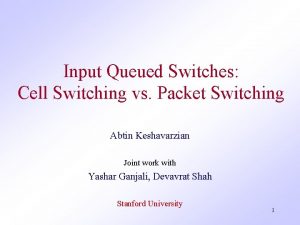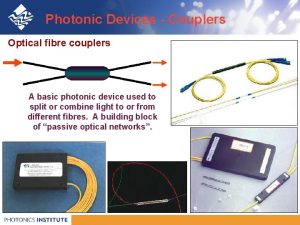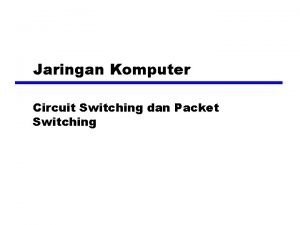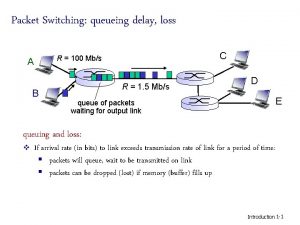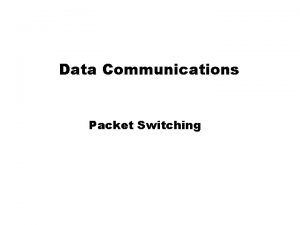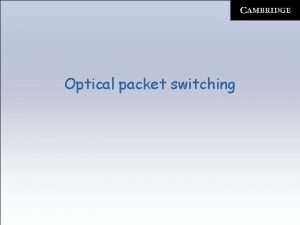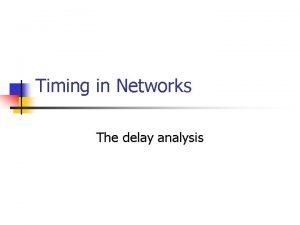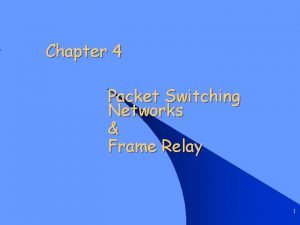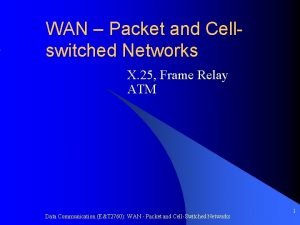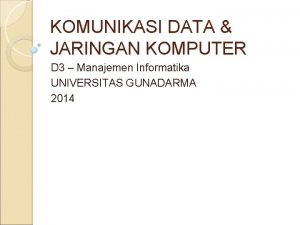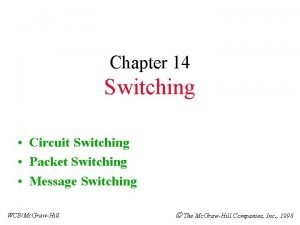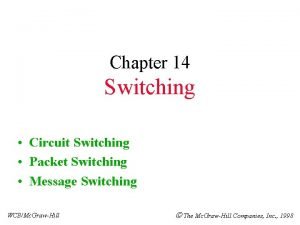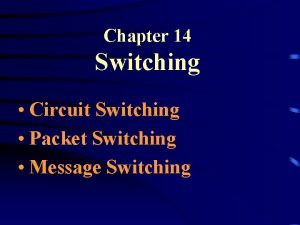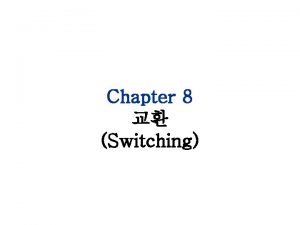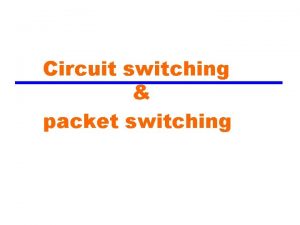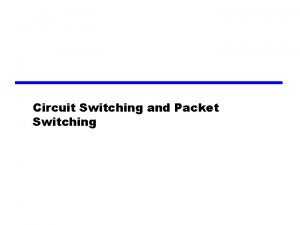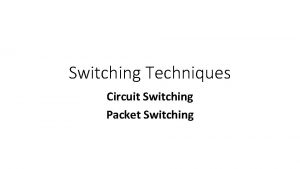Module 3 4 Switching Circuit Switching Packet Switching















- Slides: 15

Module 3. 4: Switching • • Circuit Switching Packet Switching K. Salah 1

Switching Networks • • • Long distance transmission is typically done over a network of switched nodes Nodes not concerned with content of data End devices are stations – Computer, terminal, phone, etc. A collection of nodes and connections is a communications network Data routed by being switched from node to node K. Salah 2

Circuit Switching • • • Dedicated communication path between two stations • • Must have intelligence to work out routing • • • Three phases: Establish, Transfer, & Disconnect Must have switching capacity and channel capacity to establish connection Inefficient – Channel capacity dedicated for duration of connection – If no data, capacity wasted Set up (connection) takes time Once connected, transfer is transparent Developed for voice traffic (phone) K. Salah 3

Circuit Switch Elements • • • Digital Switch – Provide transparent signal path between devices Network Interface Control Unit – Establish connections Ø Generally on demand Ø Handle and acknowledge requests Ø Determine if destination is free Ø construct path – Maintain connection – Disconnect K. Salah 4

Circuit Switching Concepts • • Blocking or Non-blocking – Blocking Ø A network is unable to connect stations because all paths are in use Ø Used on voice systems since we have Short duration calls – Non-blocking Ø Permits all stations to connect (in pairs) at once Ø Used for some data connections Two types of switches: – Space Division Switching – Time Division Switching K. Salah 5

Space Division Switching • • Developed for analog environment • Multistage Switch – Reduced number of crosspoints – More than one path through network Ø Increased reliability – More complex control – May be blocking Separate physical paths Switching is instantaneous Crossbar switch – Number of crosspoints grows as square of number of stations – Loss of crosspoint prevents connection – Inefficient use of crosspoints Ø All stations connected, only a few crosspoints in use. Ø Statistically, only 25% of the crosspoints are used at any time. – Non-blocking K. Salah 6

Time Division Switching • Switching Techniques: • • • TSI (Time Slot Interchange) TST (Time Space Time) TDM Bus K. Salah 7

TSI and TST In TSI: Ø No crosspoints Ø Processing delays Ø RAM Write and Read for each time slot Combining the advantages of Space Division switching and TSI with TST. K. Salah 8

TDM Bus This is a complete switch architecture found at the receiver end. K. Salah 9

Circuit Switching Issues • • Routing – Many connections will need paths through more than one switch – Need to find a route with Efficiency and Resilience – Public telephone switches are a tree structure Ø Static routing uses the same approach all the time – Dynamic routing allows for changes in routing depending on traffic Ø Uses a peer structure for nodes Control Signaling Functions – Subscriber to switch – Switch to switch ( commonly known as SS 7) – Transmission of dialed number – Call can not be completed indication – Call ended indication – Signal to ring phone – Billing info – Equipment and trunk status info – Diagnostic info – Control of specialist equipment K. Salah 10

Packet Switching • • Data transmitted in small packets – Longer messages split into series of packets – Each packet contains a portion of user data plus some control info Control info: Routing (addressing) info Packets are received, stored briefly (buffered) and past on to the next node, I. e. , Store and forward Advantages: – Line efficiency Ø Single node to node link can be shared by many packets over time Ø Packets queued and transmitted as fast as possible – Data rate conversion Ø Each station connects to the local node at its own speed Ø Nodes buffer data if required to equalize rates – Packets are accepted even when network is busy K. Salah 11

Datagram Approach • • • Each packet treated independently Packets can take any practical route Packets may arrive out of order Packets may go missing Up to receiver to re-order packets and recover from missing packets K. Salah 12

Virtual Circuit Approach • • Each packet contains a virtual circuit identifier instead of destination address. No routing decisions required for each packet. Two types: • SVC (Switched Virtual Circuit) • • Connection establishment Data transfer Connection Release PVC (Permanent Virtual Circuit) K. Salah 13

Virtual Circuits vs. Datagram • • Virtual Circuits – Network can provide sequencing and error control – Packets are forwarded more quickly Ø No routing decisions to make – Less reliable Ø Loss of a node looses all circuits through that node Datagram – No call setup phase Ø Better if few packets – More flexible Ø Routing can be used to avoid congested parts of the network K. Salah 14

Circuit-switched vs. Packet Switched Networks K. Salah 15
 Circuit switching vs packet switching vs message switching
Circuit switching vs packet switching vs message switching Advantages of circuit switching
Advantages of circuit switching Packet switching vs circuit switching
Packet switching vs circuit switching Cell switching vs packet switching
Cell switching vs packet switching Cell switching vs packet switching
Cell switching vs packet switching Diff between virtual circuit and datagram network
Diff between virtual circuit and datagram network Optical packet switching
Optical packet switching Packet switching principles
Packet switching principles Pengertian packet switching
Pengertian packet switching Four sources of packet delay
Four sources of packet delay Principles of packet switching
Principles of packet switching Optical packet switching
Optical packet switching Timing diagram of packet switching
Timing diagram of packet switching Frame relay packet switching
Frame relay packet switching Wan packet switching
Wan packet switching Konsep circuit switching
Konsep circuit switching



